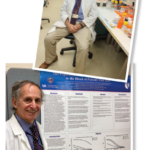 The Rheumatologist (TR) premiered in 2006, with its first full year of publication in 2007. In the 15 years since, it has sought to provide clinicians, researchers and healthcare providers with the most stimulating and educational content found in the field of rheumatology. The responsibility for achieving this mission has been borne by just three physician editors over the past decade and a half, and their insights and experiences with respect to how TR has evolved over these years are enlightening.
The Rheumatologist (TR) premiered in 2006, with its first full year of publication in 2007. In the 15 years since, it has sought to provide clinicians, researchers and healthcare providers with the most stimulating and educational content found in the field of rheumatology. The responsibility for achieving this mission has been borne by just three physician editors over the past decade and a half, and their insights and experiences with respect to how TR has evolved over these years are enlightening.
The Launch
David S. Pisetsky, MD, PhD, professor of medicine and immunology, Duke University School of Medicine, Durham, N.C., was the founding physician editor of TR. He had previously served as editor in chief of the ACR journal Arthritis & Rheumatism (since renamed Arthritis & Rheumatology), and he was excited to bring his experience as an editor to the news-magazine format.
Dr. Pisetsky appreciates the considerable latitude and discretion he was given to help shape TR. “So much science writing is bland and fails to do justice to the exciting and glorious data that it seeks to describe from scientific and clinical research,” he says. To illustrate this point, he points to an essay he wrote a few years ago about a hypothetical World Series contest as it might appear in a prestigious medical journal, with the writer reporting “with the detachment, rationality and style demanded of a scientist, the drama and feverish excitement of one of the great happenings of American sports.” (See https://blogs.scientificamerican.com/guest-blog/science-at-the-plate.) With TR, he wanted to create a periodical that would be accessible, interesting and relevant.

Dr. Pisetsky
Because most readers of TR were expected to be practitioners in the field of rheumatology, the clinical aspects of rheumatic disease and commonly encountered office issues in clinical practice were some of the main topics Dr. Pisetsky hoped to cover. For clinical topics, he notes that he has always been a proponent of well-done review articles, and TR offered a unique opportunity to showcase specific forms of this genre of medical writing. Whereas a review article for a medical journal may require hundreds of references and take months to compose, Dr. Pisetsky hoped to publish review articles that were readable, relevant, timely, and allowed writers to express their own expert opinions, using data to guide their perspectives but not get lost in the minutiae of each topic.
Dr. Pisetsky hoped that by giving clinicians the opportunity to express their views on important topics and by not making the task of writing articles too onerous, he could recruit top-notch experts to write for TR. Indeed, this is what occurred, and he was pleased both by the caliber of physician writers who contributed to TR and the response these articles received from readers, who provided positive feedback on these pieces.


